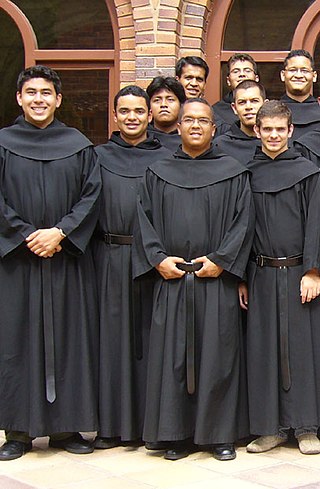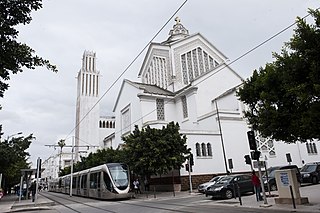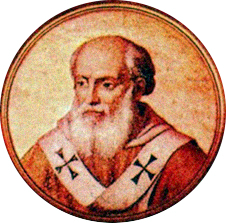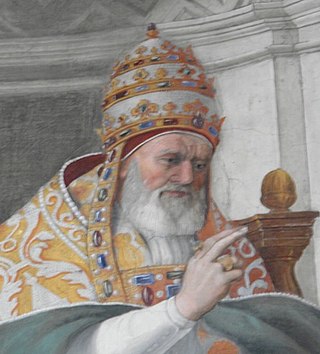
Vineae Domini custodes is a papal bull issued by Pope Honorius III in which he granted the mendicant orders of the Dominicans and Franciscans the permission to establish a mission in the Almohad Caliphate.

Vineae Domini custodes is a papal bull issued by Pope Honorius III in which he granted the mendicant orders of the Dominicans and Franciscans the permission to establish a mission in the Almohad Caliphate.
At some time before June 1225, two friars, Dominic of Segovia and Martin, asked pope Honorius III for approval of a mission to Morocco, then part of the Almohad empire. [1] Honorius III granted them this permit in a letter dating to 10 June 1225. [2] Drawing on the gospels, he told them that the goal should be to “convert the infidel, build up the fallen, strengthen the weak, comfort the doubters, and confirm the strong.” The invitation to convert Muslims marked a departure from the previous policy of popes who had limited the mission of priests and friars to pastoral care among the local Christians. [3] Honorius reissued the bull in October, this time calling on the Dominicans and Franciscans to join the Moroccan mission. He also ordered Archbishop Rodrigo Jiménez de Rada to send Dominican and Franciscan friars to undertake conversions by preaching and to appoint one of the friars as Bishop of Morocco, a role that Domonic of Segovia would take. [3]
Link to the Spanish translation of the bull

The Order of Preachers, also known as the Dominican Order, is a Catholic mendicant order of pontifical right that was founded in France by a Castilian priest named Dominic de Guzmán. It was approved by Pope Honorius III via the papal bull Religiosam vitam on 22 December 1216. Members of the order, who are referred to as Dominicans, generally display the letters OP after their names, standing for Ordinis Praedicatorum, meaning 'of the Order of Preachers'. Membership in the order includes friars, nuns, active sisters, and lay or secular Dominicans. More recently, there has been a growing number of associates of the religious sisters who are unrelated to the tertiaries.

Pope Honorius III, born Cencio Savelli, was head of the Catholic Church and ruler of the Papal States from 18 July 1216 to his death. A canon at the Basilica di Santa Maria Maggiore, he came to hold a number of important administrative positions, including that of Camerlengo. In 1197, he became tutor to the young Frederick II. As pope, he worked to promote the Fifth Crusade, which had been planned under his predecessor, Innocent III. Honorius repeatedly exhorted King Andrew II of Hungary and Emperor Frederick II to fulfill their vows to participate. He also gave approval to the recently formed Dominican and Franciscan religious orders.

Pope Gregory IX was head of the Catholic Church and the ruler of the Papal States from 19 March 1227 until his death in 1241. He is known for issuing the Decretales and instituting the Papal Inquisition, in response to the failures of the episcopal inquisitions established during the time of Pope Lucius III, by means of the papal bull Ad abolendam, issued in 1184.

Pope Nicholas IV, born Girolamo Masci, was head of the Catholic Church and ruler of the Papal States from 22 February 1288 to his death, on 4 April 1292. He was the first Franciscan to be elected pope.

The Franciscans are a group of related mendicant religious orders of the Catholic Church. Founded in 1209 by the Italian saint Francis of Assisi, these orders include three independent orders for men, orders for nuns such as the Order of Saint Clare, and the Third Order of Saint Francis open to male and female members. They adhere to the teachings and spiritual disciplines of the founder and of his main associates and followers, such as Clare of Assisi, Anthony of Padua, and Elizabeth of Hungary. Several smaller Protestant Franciscan orders or other groups have been established since late 1800's as well, particularly in the Anglican and Lutheran traditions.

Ferdinand III, called the Saint, was King of Castile from 1217 and King of León from 1230 as well as King of Galicia from 1231. He was the son of Alfonso IX of León and Berenguela of Castile. Through his second marriage he was also Count of Aumale. Ferdinand III was one of the most successful kings of Castile, securing not only the permanent union of the crowns of Castile and León, but also masterminding the most expansive southward territorial expansion campaign yet in the Guadalquivir Valley, in which Islamic rule was in disarray in the wake of the decline of the Almohad presence in the Iberian Peninsula. He was made a saint in 1671.

A friar is a member of one of the mendicant orders in the Roman Catholic church. There are also friars outside of the Roman Catholic church, such as within the Anglican Communion. The term, first used in the 12th or 13th century, distinguishes the mendicants' itinerant apostolic character, exercised broadly under the jurisdiction of a superior general, from the older monastic orders' allegiance to a single monastery formalized by their vow of stability. A friar may be in holy orders or be a non-ordained brother. The most significant orders of friars are the Dominicans, Franciscans, Augustinians, and Carmelites.

Saint Dominic,, also known as Dominic de Guzmán, was a Castilian Catholic priest and the founder of the Dominican Order. He is the patron saint of astronomers and natural scientists, and he and his order are traditionally credited with spreading and popularizing the rosary. He is alternatively called Dominic of Osma, Dominic of Caleruega, and Domingo Félix de Guzmán.
Francis of Assisi founded three orders and gave each of them a special rule. Here, only the rule of the first order is discussed, i.e., that of the Order of Friars Minor.

The Catholic Church in Morocco is part of the worldwide Catholic Church, under the spiritual leadership of the Pope in Rome. Catholics account less than 1% of the overall population of over 31 million. The country is divided into two archdioceses; Rabat and Tangier.

Christians in Morocco constitute less than 1% of the country's population of 33,600,000. Most of the Christian adherents are Catholic and Protestants.
Pablo Christiani was a Sephardic Jew who, having converted to Christianity, used his position as a Dominican friar to endeavor to convert other Jews in Europe to Roman Catholicism.

The Catholic Church during the Age of Discovery inaugurated a major effort to spread Christianity in the New World and to convert the indigenous peoples of the Americas and other indigenous peoples. The evangelical effort was a major part of, and a justification for, the military conquests of European powers such as Portugal, Spain, and France. Christian missions to the indigenous peoples ran hand-in-hand with the colonial efforts of Catholic nations. In the Americas and other colonies in Asia, and Africa, most missions were run by religious orders such as the Franciscans, Dominicans, Augustinians, and Jesuits. In Mexico, the early systematic evangelization by mendicants came to be known as the "Spiritual Conquest of Mexico".

The Catholic Church in Africa is part of the worldwide Catholic Church in full communion with the Holy See in Rome.
The Roman Catholic Diocese of Cumania was a Latin-rite bishopric west of the Siret River from 1228 to 1241. The lands incorporated into the diocese had been dominated by the nomadic Cumans since about 1100. Catholic missions began after Andrew II of Hungary granted Burzenland to the Teutonic Knights in 1211. After Andrew expelled the Knights from the territory in 1225, Dominican friars continued the Cuman mission. Robert, Archbishop of Esztergom baptized Boricius, an influential Cuman chieftain, two years later.
Events from the 1220s in England.

Non parum animus noster was a papal bull issued by Pope Alexander III on either 11 September 1171 or 1172 to promote the Northern Crusades against the pagan Estonians and Finns. It was addressed to the rulers and peoples of Denmark, Sweden and Norway and begins with a description of the threat posed by the Estonians. Alexander declared:
We are deeply distressed and greatly worried when we hear that the savage Estonians and other pagans in those parts rise and fight God's faithful and those who labour for the Christian faith and fight the virtue of the Christian name. ... to gird yourselves, armed with celestial weapons and the strength of Apostolic exhortations, to defend the truth of the Christian faith bravely and to expand the Christian faith forcefully.

Qui iustis causis is a papal bull issued by Pope Innocent IV on 23 September 1243 authorising crusades in Livonia and Prussia. Shortly after Innocent's election to the papacy, the Teutonic Order sought his consent for the suppression of the Prussian rebellion and for their struggle against the Lithuanians. It was reissued by Innocent and his successors in October 1243, March 1256, August 1256 and August 1257.

Rachel suum videns is a papal bull issued by Pope Gregory IX on 17 November 1234 calling for a crusade to the Holy Land and ordering Dominicans and Franciscans to preach in favour of it. It was issued before the truce between Frederick II, Holy Roman Emperor and the Egyptian Sultan, Al-Kamil, was due to expire.